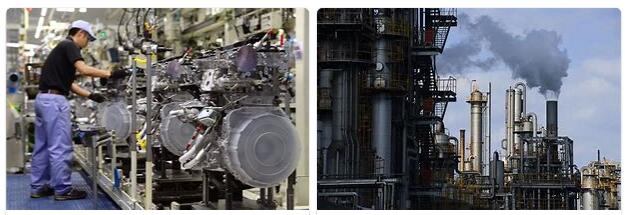With the resumption of the industrialization process following the war and post-war interlude, the well-known poverty of natural resources made itself felt especially in the sector of energy sources. Some coal production exists, but the ore is of poor quality. Local coal fields (on the Kyushu and Hokkaido islands) yielded 49,668,000 tons of fuel in 1958. Domestic production is supplemented by the importation of the finest coals from the United States, Australia, northern Vietnam, the Soviet Union, China (a total of 4,645,806 t in 1958).
Oil is very scarce. The fields currently exploited are located in Hokkaido near Sapporo and in the northwestern coastal region of Honshu, where the most productive oil district exists, in Jabase (Akita). Production in 1958 was 367,200 t. The refineries, which after the tax armistice were closed by order of the occupiers, were authorized to resume their operations in 1950. Six are in the Honshu oil region and ten on the Pacific coast. Of the refined crude oil only 2.4% is of national origin, the rest is all imported (in 1958: 14,139,218 t from Saudi Arabia, Kuwait, ‛Irāq, Indonesia, Persia). There is also a small import of refined products (97% fuel oil),
The exploitation of natural gas is also developing (1957: 243.636.000 m 3 ; 1958: 367.883.000 m 3), which about 40% is used as fuel, while the remainder is used as raw material by the chemical industries.
The increase in demand for energy sources in recent years has prompted the Japanese electricity industry to create new captures of hydraulic resources, already so intensely exploited (10,236,000 kW installed at the end of 1957, supplemented by 6,610,000 kW of systems thermal). Among the new plumbing systems are those on the Tadami, Kiso and Jintsugawa rivers. Production in 1956 was 56.721 million kWh of hydraulic origin and 23.559 million thermal ones (total production, 1956: 81.303 million kWh; 1957: 77.712; 1958: 80.280; 1959: 95.273)
It has already been noted that the loss of availability of mineral raw materials from Manchuria and Korea has put the Japanese steel industry in precarious conditions. In fact, the current Japanese territory not only lacks coal resources, but is very poor in iron ores. Today the Japanese steel industry has to import a large part of the iron ore and scrap needed from distant countries. The minerals come from India, Malaysia, the Philippines, Canada, the USA and Peru (a total of 7,613,774 t in 1958). The scrap comes mainly from the United States and also from India, Hong Kong and Australia (altogether 1,353,522 t in 1958). The iron ore deposits currently exploited in the The Japanese archipelago is located near Kamaishi in northern Honshu and in Hokkaido (production in 1958: 1,102,000 tons of metal content). Minor deposits are known at various locations in Honshu and at Niihama on Shikoku Island. The steel plants are distributed in all three major islands: in Muroran, at the coal and iron fields of the island of Hokkaido; in Hachinohe, in Kamaishi, in Tokyo, in Kawasaki (on the outskirts of Tokyo itself), in Chiba, in Shimizu and Hiroshima, in the island of Honshu, in Yawata (they are the largest) and in Kokura, in the coal fields of the Kyushu island. In 1958, production was 7,692,000 tons of cast iron and ferro-alloys and 12,120,000 tons of steel.
According to WATCHTUTORIALS.ORG, the exploitation of cupriferous deposits, which are the main Japanese resource in the metal ores sector, continues (in Kosaka, Ashio and Hitachi, on the island of Honshu, and in Besshi, on the island of Shikoku; production in metal content in 1957: 81.700 t). The ore refineries are located in Kosaka, Nikko, Annaka, Osaka, Takehara, Niihama, Saganoseki (1957: 108,900 t of copper; 1958: 103,200 t).
Lead and zinc deposits are still being exploited on the island of Honshu (refining plants in Kameoka and Hosokura; in 1957, lead 56,800 tons; zinc 136,000 tons). Gold is mined in Honshu and Kyushu; silver in these same islands and also in Hokkaido. The productions in 1959 were respectively 10,208 kg and 294,800 kg.
Among the non-metallic minerals, in addition to hydrocarbons, sulfur is exploited (in Matsuo, Azuma and Ogushi), of which there are still substantial deposits. Production in 1957: 258,000 t (the largest in the world after that of the United States).
Despite the absence of bauxite in the subsoil, there is a significant production of aluminum in Japan based on the import of the ore. In 1958, 84,600 tons of metal were produced.
The mechanical industry has now reached or surpassed its pre-war positions. The shipbuilding industry, with around 70,000 employees (Niigata, Tokyo, Yokohama, Nagoya, Osaka, Kobe, Hiroshima, Fukuoka and Nagasaki), produced over two million tonnes of shipping per year in the years 1956, 1957 and 1958. In 1956 the ships built on behalf of foreign clients constituted the most important voice of the Japanese export trade. The automotive industry, with about 100,000 employees (Tokyo, Yokohama and Nagoya), manufactured about 190,000 vehicles in 1959. Also important are the railway equipment (Tokyo, Yokohama, Osaka, Kobe) and bicycle (Tokyo, Osaka, Nagoya) industries.). On the other hand, the textile machinery industry and the sewing machine industry suffer from the loss of ancient export markets.
The industries of optical devices (over half a million cameras a year), precision mechanics (five million clocks), electrical equipment, electronic equipment, transistor radio receivers are very flourishing.
